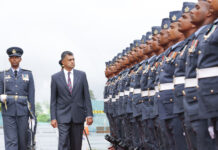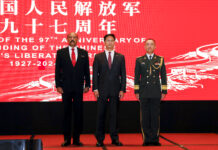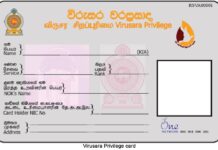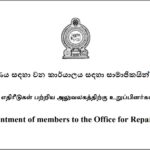When the Royal Ceylon Air Force was formed in 1951, a team of British officers seconded from the Royal Air Force realised the importance of having local personnel trained to maintain the fleet of aircraft. They recruited batches of young Ceylonese boys to be trained in the various aircraft engineering trades and sent most for training to RAF Halton, England.
By: an Ex-‘Brat’
When the Royal Ceylon Air Force was formed on March 2, 1951, a team of British officers seconded from the Royal Air Force was entrusted with the task of building up this new arm of the Ceylon defence force. They realised the importance of having local personnel trained to maintain the fleet of aircraft that was coming soon to equip the fledgling RCyAF.
With this in view, they recruited, at three monthly intervals, batches of Ceylonese boys between the ages of 15 l/2 and 17 l/2, to be trained in the various aircraft engineering trades. Most of the recruits were sent to RAF Halton, England, but around 20 in the radio and radar trades went to RAF Cranwell, which later moved to Locking. All went through a three-year apprenticeship, which also catered to young men from Pakistan, Burma, Rhodesia and New Zealand, in addition to the UK.
The RAF apprenticeship scheme was the brainchild of Air Marshal Hugh Trenchard, then Chief of Staff of the RAF. At his instigation, No. 1 School of Technical Training, RAF Halton, was founded in 1922. Before long, the apprentices earned the nickname ‘Brats’. The origin of this tag is explained in a book about RAF Halton published by an ex-apprentice Max Cocker: “The spread of mere boys with a high degree of technical training and, no doubt, the brash cockiness of youthful confidence, earned them the derogatory term of ‘Brat’ from their seniors, but this term, with its connotation of Halton and high standards, was adopted as a badge of honour and is still worn today with pride.”
In April 1951, ten young Ceylonese potential ‘Brats’ boarded an aircraft at the old Katunayake airport for a journey to faraway England. Fifty years ago, it was the dream of most Sri Lankan men and women to travel to distant United Kingdom. So, these ten boys, the first batch of RCyAF aircraft apprentices, acquired the status of instant celebrities in their hometowns.
Not just the boys but their parents too. A Lankan shopkeeper was heard to ask a customer, pointing at another customer, “Do you know who that is?” Without waiting for an answer, the shopkeeper continued, “That is Mr. Abeysekera; his son is going to England tomorrow”. And the boys’ friends were understandably green with envy too. Not only had these lucky fellows joined the Air Force, but they were going to England.
Unlike the non-stop progress made by a SriLankan Airlines A340 on its 11-hour flight from Colombo to London today, the aircraft with the recruits on board stopped at Karachi, Cairo and Rome for replenishment of its fuel tanks—and to give passengers respite from the engines’ deafening drone, and the opportunity to stretch their legs after long hours of confinement.
The distinction of being the first Ceylonese apprentice went to Douglas Abeysekera, a pupil of Holy Cross College, Kalutara, who later retired as a Squadron Leader. The last of the apprentices, Cyril Siriwardena from Homagama, also retired from the SLAF as a Squadron Leader a couple of years ago. The youngest boy to join the apprenticeship scheme—just 13 days after his 16th birthday—was Edgar Cooray, who later qualified as a pilot, and also retired a Squadron Leader.
After completing their initial period of service, many of these former apprentices, now highly-trained, British-qualified technicians, were lured away from the Air Force by various multi-national companies setting up production plants in Sri Lanka. Now, most of them are domiciled in the UK, Canada and Australia.
Of those who left the Air Force for civilian life, Duncan Perera and Nelson Balasuriya, both old Anandians, became, respectively, Manager-Industrial Relations of Lever Brothers, and Director of Reckitt and Colman, and later Consultant Director of the same company in Nigeria. T.C. Buckman is a senior partner of Fire Tech Industries, and Nissanka Ediriwira is Chairman of Weigh Tech (Pvt) Ltd, and a Director of Lionair. Whilst at RAF Hereford, Ediriwira had the honour of passing out top of his administrative apprenticeship course, and commanded the passing-out parade that year.
Sarath Illukkumbura retired as Principal of the Sri Lanka-German Technical Training Institute, and the late W.N.T. Fernando was Chairman of the Colombo Central Transport Board. Today, Tom de Silva runs his own catering service, having retired from the Ceylon Tobacco Company, while Roland Abeygoonawardena is factory manager of Maliban Chocolates, and Nicky Kuruutumpala the factory manager of Selma Packaging. Cyril Fernando was commercial manager of Union Carbide.
- Jayaweera was a senior manager at Lemminkapnan Ltd, and Wimal Siriwardena an area manager for the Ceylon Petroleum Corporation. N. Balasubramaniam runs his own construction company, like S.D Gunasekera who owns an optical business in Kandy. Neil Abeynayake is Senior Manager at Grip Furnitures, and E.L.W. Hapugoda was the works manager of the Hardware Manufacturing Corporation.
Alex Dharamasothy was a training manager at Ceylon Tobacco Company, and Kingsley Weerasinghe a senior manager of the same organisation. The late Hugh Dassanayake was a Director of Upali Aviation, and the late Jayantha Gunawardena was head of Motorola in Sri Lanka. Others like Vernon Ananda, Neville Bowatte, Mano Danvers, T Sulaiman and S. Samsudeen went to work in West Asia, Siri Fernando had a long stint with British Airways.
The few who opted to stay behind in the Air Force after the mass exodus of the 1960s included Noel Lokuge, who retired as a Squadron Leader-Pilot Instructor. Lokuge was the first Sri Lankan to eject from a jet aircraft when he hurriedly evacuated his Jet Provost over the Negombo lagoon. He later flew as a VIP Pilot for the Maldivian government. Edgar Cooray went on to become Commanding Officer of No. 2 Squadron of the S.L.A.F. After retirement from the Air Force in 1977, he flew Convair 440 passenger aircraft for Air Maldives, was recalled to the Air Force and appointed as Commandant of the Bandaranaike International Airport.
Later, Cooray served as the Senior Operations Officer of the Royal Oman Police Air Wing, and finally as Crew Scheduling Manager of AirLanka.

Andy Ginige who retired from the Air Force as a Flight Lieutenant also worked in the Royal Oman Police as their Senior Movements Officer, and Dougie Abeysekera did a spell with the Oman Air Force too. T.C. Buckman, Carlyle Palliyaguru and Tuan Sulaiman became Warrant Officers in the SLAF.
Herbert Marasinghe, a brilliant student at Ananda College, was awarded a technical apprenticeship for direct entry to the RAF. He did very well, but when offered an officer’s commission by the RAF, decided to return to Ceylon and the RCyAF, ending his illustrious career as Group Captain and Senior Technical Officer of the SLAF.
The handful of ex-apprentices remaining in Sri Lanka have formed an alumni (‘Old Boys’) group, like many others around the world, and are affiliated to the RAF Halton Aircraft Apprentices’ Association in the UK. Duncan Perera is President, and Edgar Cooray the Secretary of the group, which meets regularly, along with members’ wives, to foster social contact and reminisce about their apprentice days.
In a message of congratulations, Commander of the SLAF, Air Marshal Jayalath Weerakkody says that the qualified apprentices “were able to successfully replace the technicians and NCOs seconded from the RAF (and) thereafter not only did they maintain the fleet of RCyAF aircraft in excellent shape, they also took over the task of training the new batches of technicians after the training in the UK ceased. The dedicated and tireless service of these apprentices has immensely contributed towards the successful emergence into and expansion of the SLAF to the hi-tech era”.
Adding his felicitations for the Jubilee souvenir, Group Captain Ian Blunt, chairman of the Halton Aircraft Apprentices’ Association in the UK writes: “Many of you became NCO apprentices and many did very well in both School and Workshops. You contributed to the school’s sporting scene, and I recall myself that one or two of you achieved some little fame amongst the local ladies. Most of all, however, you managed to confound completely the pronunciation skills of the average Drill Instructor, to the delight of the rest of us”. Blunt concludes, “You were few in number, but are still very fondly remembered.”
While the apprenticeship scheme may have been terminated several years ago, the surviving ‘ex-Brats’ are determined to keep the flame alive. In the midst of all their successes in later life, these former apprentices still harbour a soft spot and unwavering loyalty for the Air Force that nurtured them and changed them from boys to men.












